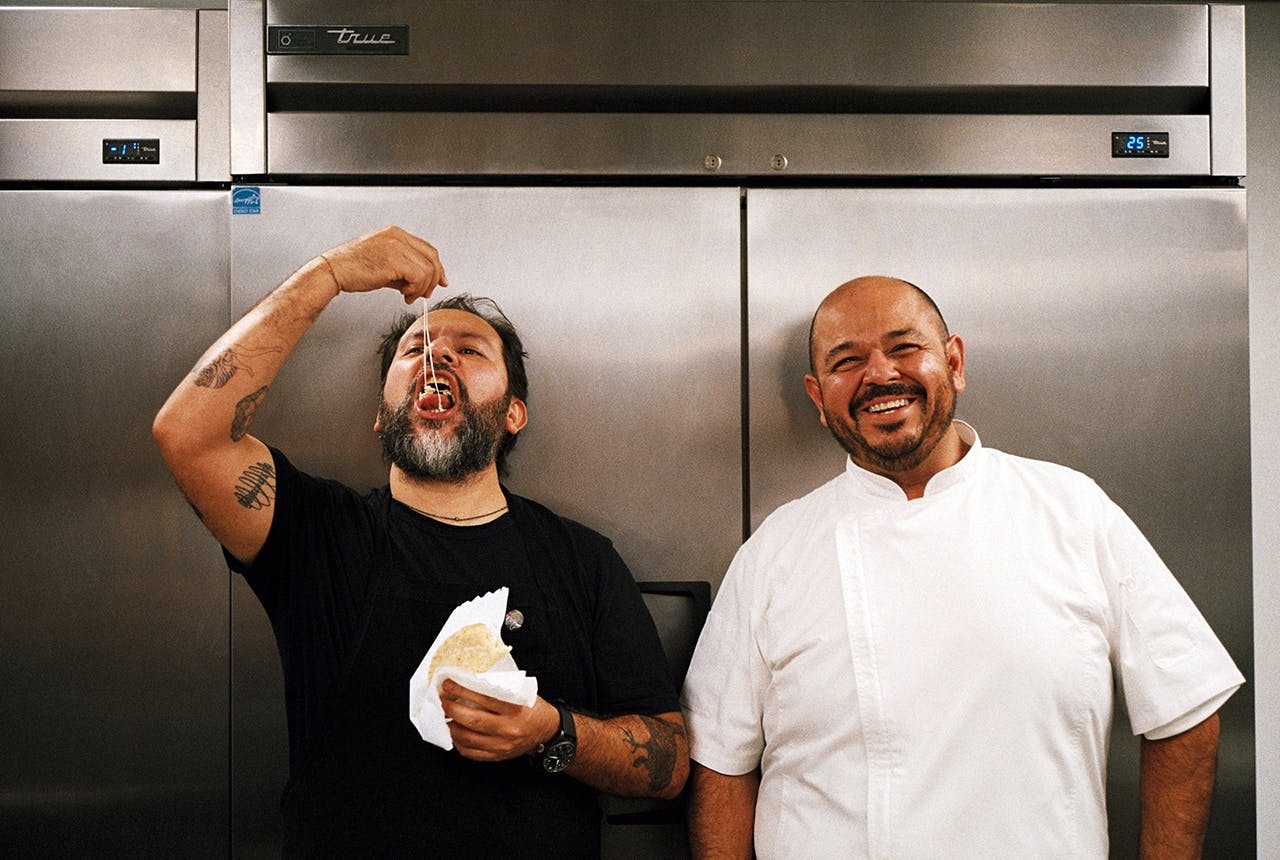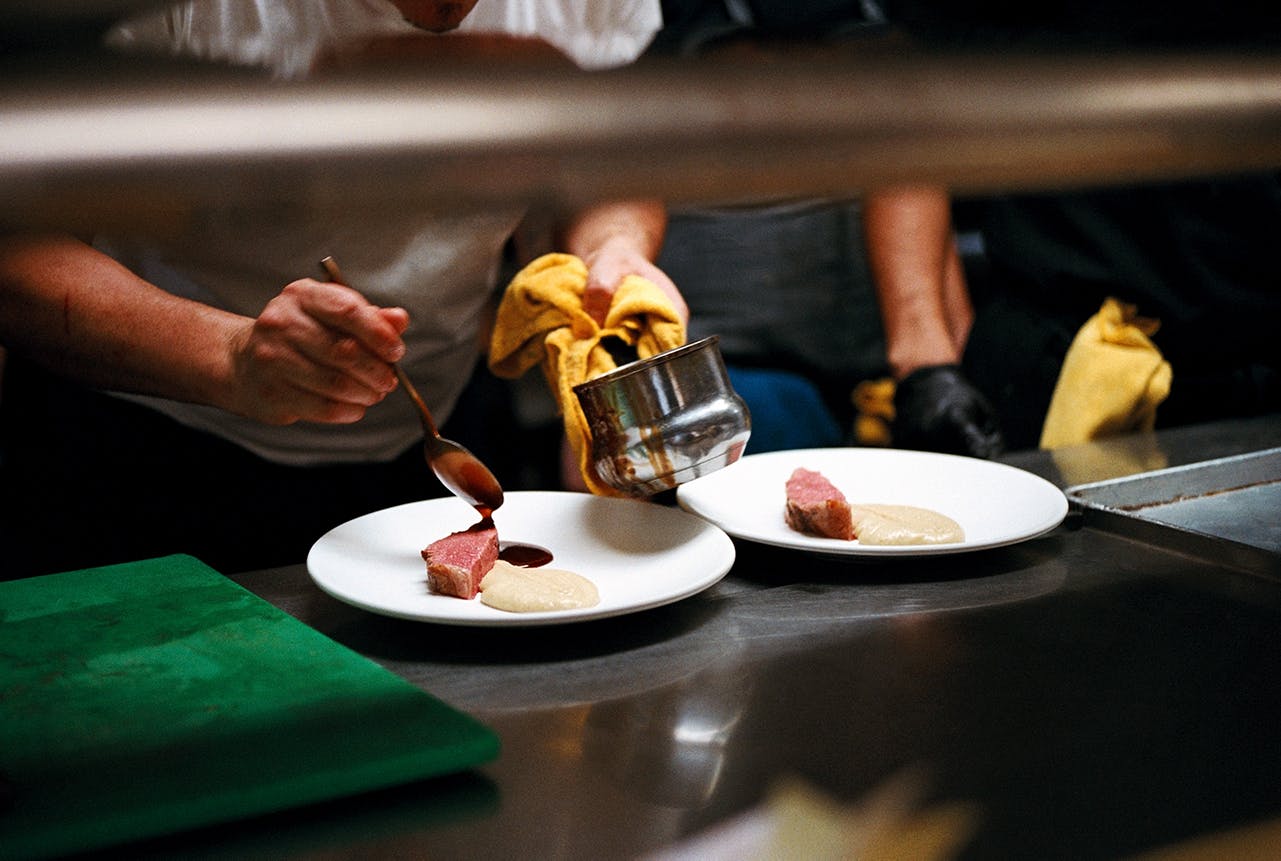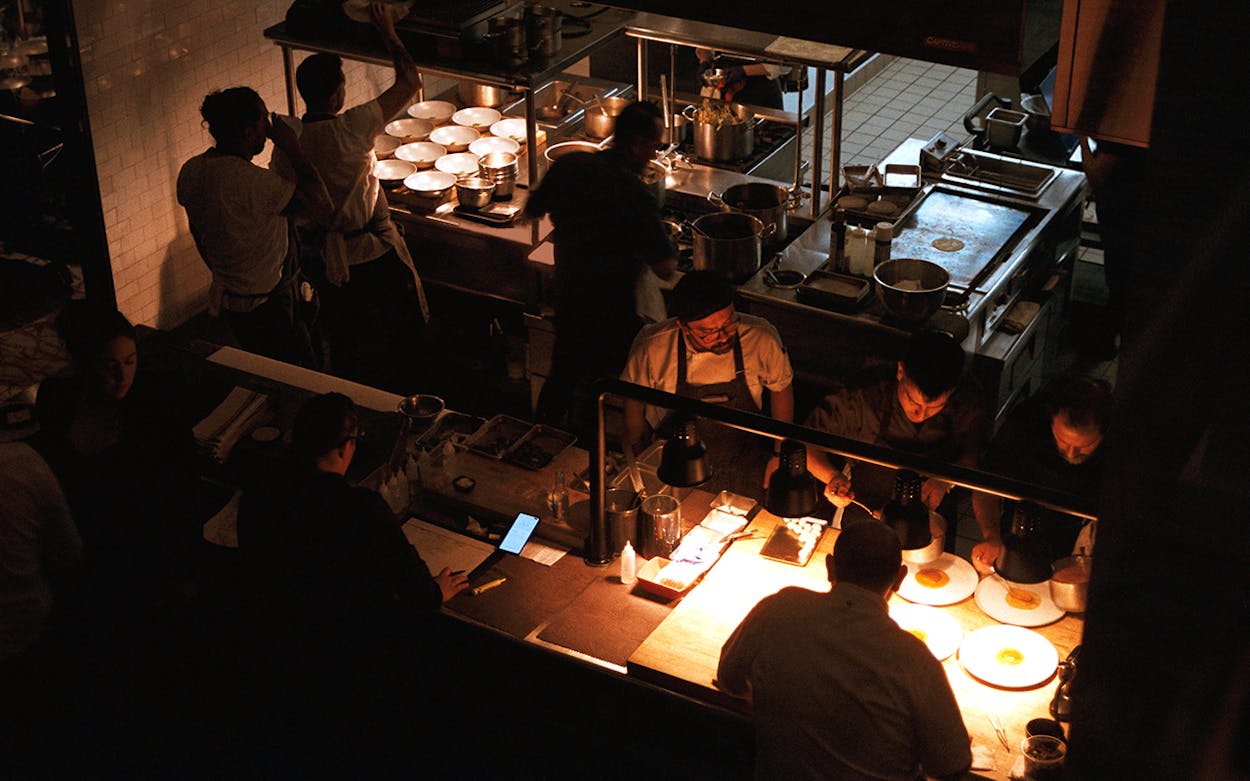Hot, behind,” yells a cook, a boiling pot of sauce in hand. “Corner,” hollers another, rounding the turn between the dishwashing station and the prep area. It’s the middle of dinner service at Taft-Díaz in El Paso, and a dining room filled with customers anxiously awaits the next dish of the evening’s seven-course tasting menu. An air of intense concentration permeates the kitchen. Fifteen cooks move about hectically, but without the screaming or swearing that often goes hand in hand with pressurized restaurant environments.
David Linares, a visiting cook from acclaimed Mexico City restaurant Pujol, takes notice of a member of the local Taft-Díaz crew. While plating desserts, she’s struggling to scoop the ice cream into an elegant quenelle. Despite contending with an onslaught of orders himself, Linares comes to her aid. He dips a spoon into hot water, places it in the container of ice cream, and with a steady swoop of the wrist, produces the perfect football-shaped dollop. He demonstrates several more times before handing the spoon back to his new colleague. Linares returns to other tasks, but later in the evening, he checks on her progress. He’s giddy with excitement when he witnesses her improvement. This small interaction, as two restaurant teams unite as one, subtly exemplifies the sort of cross-cultural convergence that takes place daily in the binational community of El Paso-Juárez.

Pujol, where Linares usually works, is led by Enrique Olvera, who is perhaps Mexico’s most renowned chef. Two of Olvera’s restaurants, Pujol and New York City’s Cosme, appear on this year’s World’s 50 Best list. Olvera has also written beloved cookbooks and shown up in multiple Netflix series. Despite this renown, he remains remarkably modest and supremely cognizant of his ability to affect change in and beyond the kitchen.
Last month, Olvera traveled with a small crew from Pujol to El Paso to participate in one of two philanthropic dinners. He and chef Eduardo García, best known for Mexico City’s Máximo Bistrot, partnered to bring variations of their iconic menus to the area for one night each. The evenings were to benefit Spanish photographer Zahara Gómez and her project on Mexico’s disappeared—victims of the country’s cartel-related violence.
After photographing families still searching for lost loved ones, Gómez set out to highlight the connections between food and memory. “I really wanted to have people from the inside of the kitchen involved,” she says of her decision to solicit Olvera and García’s help. Proceeds from the events would raise funds for the publication of a cookbook filled with the favorite recipes of those missing, alongside her photos.
“When I heard these stories and understood that a person could be remembered by what they ate, I immediately wanted us to be a part of the project,” Olvera says. “We have a responsibility to our country and to our communities.” Excited to contribute, Olvera then brought to the table Oscar Herrera, a dual Mexican and American citizen who operates restaurants on both sides of the border.


In 2003, when Herrera opened Maria Chuchena with his brothers in Juárez, the city was plagued by the violence related to what Gómez now photographs—hundreds of people disappeared each year, leaving their families in a state of deep uncertainty. “We were completely consumed by fear,” he says. “But just as fear is contagious, so is hope.” A staunch believer in food as an agent for change, he made a perfect host for the two-night event.
While El Paso and Juárez lie in different countries, they are intrinsically bound. Deep familial and economic ties exist in this bicultural community that’s not the United States, nor Mexico, but something in between. “We are one,” is how Herrera puts it. “We work seamlessly every single day.”
Last December, he opened Taft-Díaz inside Stanton House, a boutique hotel and cultural hub just minutes from the Paso del Norte border crossing. Under his direction, chefs de cuisine Michael Diaz de Leon and Jorge Ortiz have crafted a menu that highlights regional ingredients and marries the culinary traditions of the Borderplex region that stretches from southern New Mexico to Juárez with a range of influences as varied as French and Japanese cuisine. “Marrow and mussels, for example, represents the border because of all the fusion within the dish itself,” Ortiz says. “You can’t define it as one thing, one culture, one specific type of food, and that feeling really resembles day-to-day life on the border.”
The entire Taft-Díaz staff is native to the area. Some live in El Paso, while others cross daily into the city from Juárez . “The team, from the cooks to the dishwashers and the bartenders, is 100 percent bilingual,” Diaz de Leon says. “We’re able to understand food through two different languages.” The border has long been culturally porous, a fact rarely acknowledged by those who haven’t spent significant time in these parts. “The closer that you are to the border, the more opportunity you see. The further away that you are, the greater threat you see,” says Stanton House cofounder Martin Morgades, reciting a favorite regional adage.
Olvera has made multiple trips to West Texas and Northern Mexico. Not long before the El Paso event, he’d traveled to Marfa for its Agave Festival, posting images of his eating adventures on Instagram. “People understand that collaboration is the only way to survive,” he says of the border’s residents. “That mentality is something that we can all learn from.” Consequently, for the first of the dinners, Olvera wed two crews—his own, a small group from Pujol that included chef de cuisine Alex Bremont and assistant general manager Natalia Magaña, and that of Taft-Díaz. Together they diligently weathered the challenges of the highly anticipated service.

“Oígo,” the kitchen staff sang out in acknowledgement after six huitlacoche dishes were ordered. Moments later, a Taft-Díaz cook delivered thinly sliced and charred avocado to Ortiz, who plated each segment in a bowl just as Olvera’s spoon layered in warm huitlacoche, a fungus grown on corn. Bremont stood right behind, vigorously shaving black truffle on top to complete the dish. This sequence, among countless others, was carried out dozens of times in near silence. The roughly 140 patrons who cycled through the dining room, meanwhile, reveled in Pujol’s famous moles—one of which had been aged 1,999 days—and smoked baby corn with chicatana-ant mayonnaise.
Bringing a taste of Pujol to another environment is no small feat. In Mexico City, Olvera’s crew operates like a finely tuned orchestra. Yet the Taft-Díaz staff quickly adapted to the demands of Pujol’s menu and procedures. From peeling, de-yolking, and filling boiled quail eggs to removing the veins from bright green hoja santa leaves, they ably dealt with unfamiliar ingredients and intricate methods. Instead of simply tackling the complicated tasks themselves, Olvera and his team made time to ensure that their counterparts walked away with additional skills.
In the open kitchen, both groups fell into a rhythm, making quiet adjustments to their movements and communication. By night’s end, having bolstered and learned from one another, they had become a cohesive unit. All the while, they developed new friendships. Over post-service quesadillas and drinks, a respite after a job well done, they were already discussing ways to reunite.
The next evening, on the other side of the Rio Grande in Juárez, it was García’s turn to shine. Like Olvera, García is a leader in Mexico City’s culinary scene. He too has appeared on prestigious lists, and all three of his restaurants—Máximo Bistrot, Havre 77, and Lalo!—receive their fair share of rave reviews from customers. “Success isn’t why my wife Gabriela and I started our business,” García says. “But with success, we realized that we had the power to do good. Food can save the world, literally—for our stomachs, but also for our souls.”

García was eager to participate in the charitable event, but he couldn’t travel to El Paso. The chef, a son of migrant farmworkers, grew up in the United States, where his family still lives. “Mentally,” he says, “I became an American.” Nonetheless, he didn’t have the documents to prove as much and was deported twice. In Juárez, García, Gabriela, and another of their cooks offered Maria Chuchena’s crew a chance to study Máximo’s inner workings. Before service, a gathering of press congregated in the restaurant entrance, but García was adamant that he only had five minutes for interviews. His time in the kitchen, with the cooks and waitstaff, was his priority.
This visit by a world-recognized chef spoke to the city’s slow but ongoing rebirth after an era of chaos and bloodshed, and Juárez residents filled every seat at Maria Chuchena. Orders arrived in quick succession—ten ceviche tostadas, six ribeyes, and eight chocolate-macadamia tarts. Not one station blinked an eye. Gabriela and two cooks meticulously topped the fried tortillas with fish, while the hot line, shepherded by García, sliced and plated the meat. The other cook visiting from Máximo dusted the tarts with cocoa powder as her Maria Chuchena counterpart furiously whipped vanilla cream to the perfect consistency. The waitstaff cycled through endlessly, carrying the dishes to enthusiastic tables.
García observed the goings-on but largely left the local team to manage the service. Cracking jokes and sipping beers as they worked, the combined group looked to outsiders like they had long shared the kitchen. As the last of the desserts reached the dining room, the staff gathered around García and Herrera. They breathed a collective sigh of relief and were ready to celebrate. Upstairs, the Maria Chuchena crew had secretly prepared a cake topped with sparklers to celebrate Gabriela’s birthday.


It is an accomplishment for teams like these, familiar with their carefully designed work environments, processes, and people, to join forces with such finesse. One crew was tasked with opening a version of their restaurant in a foreign place for a night; the other had to follow suit. Despite the challenge, they found the space to swap perspectives on ingredients and cooking styles and share techniques. In a combined effort, they used these meals as an attempt to alter wider perceptions about the border region.
Mexico and the United States are often depicted as being at odds, but in these borderlands and at these two dinners, it’s difficult to view them as anything other than the best kind of neighbors. “There are security issues. There are immigration issues. At the end of the day, however, there is also a community, not concerned with nationality but with creating great things,” Diaz de Leon says. “I never understood just how powerful my profession can be. What better way to bring light to our region, or to meaningful efforts like Zahara’s, than through food?”
- More About:
- Mexican Food
- Juárez
- El Paso






